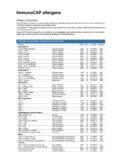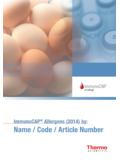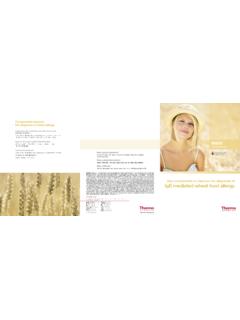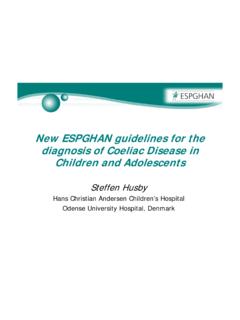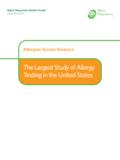Transcription of Directions for Use ImmunoCAP ISAC Assay Kit IgE …
1 Directions for Use ImmunoCAP ISAC Assay Kit IgE. ImmunoCAP ISAC Starter Kit IgE. For Research Use Only 20-01-02-3-EN-RUO. Trademarks/Marques/Varemerker/Warenzeich en/Varemaerker/. Marchi despositati/Marchas registradas/Varum rken/Marcas registradas The following designations are registered trademarks belonging to Phadia AB: ImmunoCAP . The following designations are registered trademarks belonging to Phadia Multiplexing Diagnostics GmbH: ISAC. The following designations are trademarks belonging to CapitalBio Corporation: LuxScan Bibliography See page 12. Developed by: Phadia Multiplexing Diagnostics GmbH, Wien, Austria, and Phadia AB, Uppsala, Sweden Issued April 2008. Revised May 2009. Phadia AB, Uppsala, Sweden Page 2. INTENDED USE. ImmunoCAP ISAC IgE is an in vitro test for semi-quantitative determination of specific IgE. antibodies in human serum or plasma.
2 It is intended for Research Use Only. SUMMARY AND EXPLANATION OF THE TEST. Immediate type of allergic reactions is a function of antibodies belonging to the IgE class of immunoglobulins. Clinical manifestations such as asthma, hay fever, atopic eczema and gastro intestinal symptoms develop after exposure to specific allergens (1). Determination of the sensitization pattern to specific and/or cross reactive allergen components assists in a more detailed evaluation of the allergic patient (2-12). PRINCIPLES OF THE PROCEDURE. ImmunoCAP ISAC IgE is a solid-phase immunoassay. Allergen components that are immobilized on a solid substrate in a microarray format are incubated with human serum or plasma samples to detect specific IgE antibodies. Binding of the specific IgE antibodies to the immobilized allergen components is detected by the addition of a secondary fluorescence-labeled anti-human IgE.
3 Antibody. The procedure is followed by image acquisition using an appropriate microarray scanner. The ISAC Standardized Units for specific IgE (ISU) are determined and the test results are analyzed with proprietary software (MIA - Microarray Image Analysis Software). Figure 1. Top left: Schematic of allergen component microarray layout. Top right: Schematic of Assay principle. Allergen components are covalently coupled to the solid phase. Allergen specific IgE antibodies are detected by fluorescence-labeled anti-IgE. Bottom left: Scan image of fluorescence laser scanning microscope showing different intensities from black (negative). to white (strong positive) on false color scale. Bottom right: Schematic of ImmunoCAP . ISAC Assay Kit IgE Assay reporting. Page 3. REAGENTS. ImmunoCAP ISAC Assay Kit IgE and ImmunoCAP ISAC Starter Kit IgE contain the reagents required to perform an Assay .
4 The expiration date and storage temperature for each kit is stated on the outer label. However, each component is stable until the date stated on each individual component's label. It is not recommended to pool any reagents. ImmunoCAP ISAC Starter Kit IgE (Art No 81-1001-01). (for 20 determinations). ImmunoCAP ISAC IgE 5 chips Store at 2-8 C until expiration date. including 4 reaction sites Allow to reach ambient temperature before opening vacuum seal. After vacuum seal is broken chips can be stored for 6 weeks if kept dry and dark at 18 32 C. Do not reuse. Component A 1 bottle Store at 2 - 8 C until expiration date. (20 x Buffer), 200 ml IgE Detection Antibody 1 vial Ready for use. 20 determinations. (Fluorescence conjugated anti- Store at 2 - 8 C until expiration date. Store human IgE), 0,5 ml protected from light. IgE Control Serum 1 vial Ready for use.
5 1 determination. (human serum). 50 l Do not dilute control serum ! Sodium azide <0,1% Store at 2 - 8 C until expiration date. Washing Dish 2 dishes for 10 Ready for use. chips Magnetic stirrer bar 2 Ready for use. Humidity Chamber 1 chamber for Ready for use. 26 chips Page 4. ImmunoCAP ISAC Assay Kit IgE (Art No 81-1000-01). (for 20 determinations). ImmunoCAP ISAC IgE 5 chips Store at 2-8 C until expiration date. including 4 reaction sites Allow to reach ambient temperature before opening vacuum seal. After vacuum seal is broken chips can be stored for 6 weeks if kept dry and dark at 18 32 C. Do not reuse. Component A 1 bottle Store at 2 - 8 C until expiration date. (20 x Buffer), 200 ml IgE Detection Antibody 1 vial Ready for use. 20 determinations. (Fluorescence conjugated anti- Store at 2 - 8 C until expiration date. Store human IgE), 0,5 ml protected from light.
6 IgE Control Serum 1 vial Ready for use. 1 determination. (human serum), 50 l Do not dilute control serum ! Sodium azide <0,1% Store at 2 - 8 C until expiration date. Other Materials Materials required but not provided by Phadia AB: Measuring cylinder 1000 ml Purified water Magnetic stirrer Y PRECAUTIONS. For Research Use Only. Not for internal or external use in humans or animals. Do not use reagents beyond their expiration dates. It is recommended to wear hand and eye protection and follow good laboratory practices when preparing and handling reagents and samples. This kit contains reagents manufactured from human blood components. The source materials have been tested negative by immunoassay for hepatitis B surface antigen and for antibodies to HIV1, HIV2 and hepatitis C virus. Nevertheless, all recommended precautions for the handling of blood derivatives should be observed.
7 Please refer to Human Health Service (HHS). Publication No. (CDC) 93-8395 or other local/national guidelines on laboratory safety procedures. Warning! Reagents that contain sodium azide as a preservative must be handled with care. Safety Data Sheet available from Phadia AB on request. Page 5. Handling of ImmunoCAP ISAC. Do not label with pens or markers that are soluble in water or organic solvents. Residuals of labeling can interfere with the fluorescence-based analysis of ImmunoCAP ISAC. If necessary, use a pencil for labeling. Avoid direct contact with the surface of ImmunoCAP ISAC during any of the reaction steps. Always touch ImmunoCAP ISAC at the margin of the glass slide. PREPARATION OF SPECIMEN, REAGENTS AND EQUIPMENT. Specimen Serum or plasma samples from venous or capillary blood can be used. Collect blood samples using standard procedures.
8 Keep specimens at room temperature for shipping purposes only. Store at 2 8 C for up to one week or at 20 C for prolonged storage. Avoid repeated freezing and thawing. Solution A. Prepare 700 ml of a fresh 1:20 dilution of Component A in purified water to obtain Solution A (add 665 ml purified water to 35 ml Component A). The volume is calculated for 3 washing steps of 220. ml each, using the Washing Dishes provided with the Starter kit. The volume of the dilution shall be adjusted individually to the container being used. IgE Detection Antibody IgE Detection Antibody solution is ready for use. Protect from light and avoid freezing. Humidity Chamber Place a fresh paper towel in the bottom of the humidity chamber and soak it with purified water. Until further use, close the lid of the humidity chamber to prevent evaporation. ImmunoCAP ISAC.
9 Put ImmunoCAP ISAC into the Washing Dish containing the removable glass slide rack (up to 10. chips) and approximately 220 ml of Solution A together with a magnetic stirring bar in the bottom of the dish. Place it onto a magnetic stirrer and stir vigorously for 60 minutes. Move the glass slide rack containing the ImmunoCAP ISAC into a separate Washing Dish containing approximately 220. ml purified water. Add a stirring bar and stir vigorously on a magnetic stirrer for 5 minutes. Remove the glass slide rack containing ImmunoCAP ISAC and place it onto a paper towel and leave to air- dry. Wait until the chips are completely dry. Continue with the Test Procedure immediately afterwards. Discard all used washing solutions. Page 6. TEST PROCEDURE. Place the prepared ImmunoCAP ISAC IgE in the Humidity Chamber with the reaction sites up. Pipette 20 l of each sample onto one reaction site (there are 4 reaction sites available per chip).
10 Close the Humidity Chamber carefully, without mixing the samples. It is recommended to use one IgE Control Serum per ImmunoCAP ISAC Assay Kit IgE. Assay of IgE Control Serum is mandatory if changes to the Assay or scanning procedure are introduced. Avoid direct contact of the pipette tip with the surface of ImmunoCAP ISAC IgE when dispensing the sample. Incubate at room temperature for 120 minutes. Remove ImmunoCAP ISAC IgE from the Humidity Chamber carefully, without mixing the samples. Remove the samples by tapping the chip with its long side on a fresh paper towel. Be careful to shake off the samples at right angles with the glass edge to avoid samples running over neighboring reaction sites. Wash ImmunoCAP ISAC IgE with approximately 220 ml Solution A for 10 minutes (using the Washing Dish and the magnetic stirrer, as described previously).
